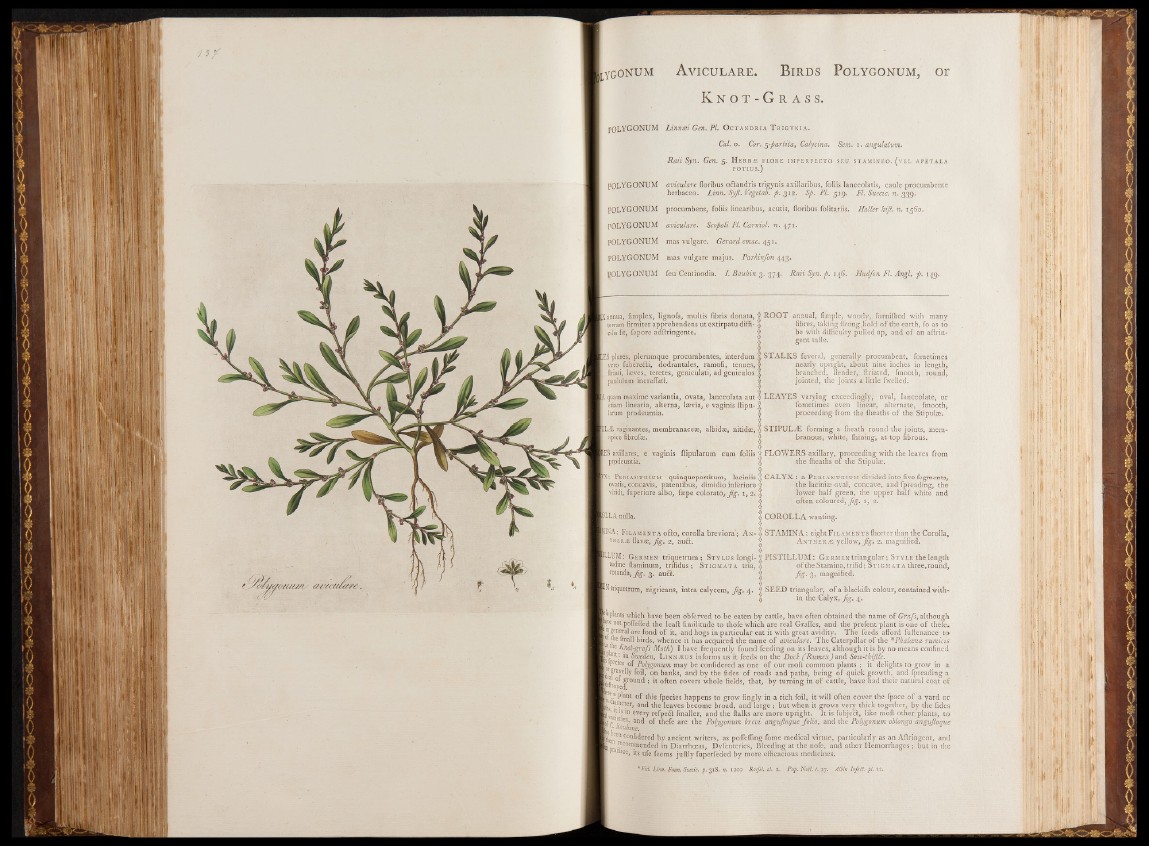
Jygonum Aviculare. Birds Polygonum, or
K n o t - Grass.
POLYGONUM Linncei Gen. PI. Oc t a n d r ia T r ig yn ia .
. Cal. o. Cor. 5-partita, Calycina. Sem. 1. angulatum.
Rail Syn. Gen. 5. Herbie flore imperfecto seu stamineo. (vel ape ta la
potius.)
POLYGONUM aviculare floribus oftandris trigynis axillaribus, foliis lanceolatis, caule prdcumbetite
herbaceo. Linn.Syfi.Vegetab. p. 312. Sp. PI. 519. FI. Suecic. n . 339.
POLYGONUM procumbens, foliis linearibus, acutis, floribus folitariis. Haller hiß. n. 1560.
POLYGONUM aviculare. Scopoli FI. Carniol. n. 471.
POLYGONUM mas vulgare. Gerard emac. 451.
POLYGONUM mas vulgare majus. Parkinfon 443.
POLYGONUM feu Centinodia. I. Bauhin 3. 374. Rail Syn. p. 146. Hudfon Fl. Angl, p. 149.
K annua, fimplex, lignofa, multis fibris donata, $ ROOT annual, Ample, woody, furnifhed with many
' terrain flrmiter apprehendens utextirpatu diffi- 4 flbres, taking ftrongthold of the earth, fo as to
cilis fit, fapore adftringente. 4 ' be with difficulty pulled up, and of an aftrin-
| . gent tafte.
lES plures, plerumque procumbentes, interdum a STA LK S feveral, generally procumbent, fometimes
1 vero fubere&i, dodrantales, ramofi, tenues, $ nearly upright, about nine inches in length,
ftriati, laeves, teretes, geniculati, ad geniculos‘a branched, llender, ftriated, fmooth, round,
paululum incraflati. <S> jointed, the joints, a little fwelled.
-■ A quam max.ime van.a nti. a, ovata, lanceolata aut V<> LEAV•• E• So varying exceedingly, oval, lanceolate, or
etiam linearia, alterna, lasvia, e vagini's ftipu- f fometimes even linear, alternate, fmooth,
lariim prodeuntia. X proceeding from the {heaths of the Stipulas.
jULE vaginantes, membranaceae, albidae, nitidae, X STIPULAL forming a {heath round the joints, mem-
apice fibrofee;. $ branous, white, ftiining, at top fibrous.
. . • . . . - • '1'.'* X M
RES axillares, e vaginis ftipularum cum foliis | FLOWERS axillary, proceeding with the leaves from
prodeuntia. | the {heaths of the Stipulas.
]X: Perianthium quinquepartitum, laciniis <
ovatis, concavis, patentibus, dimidio inferiore <
viridi, fuperiore albo, faepe colorato, fig. 1, 2. /
• <
|)LLA nulla.
JIINA: Fil am en ta 06I0, corolla breviora; A n-
1 ther/e flavae, Jig. 2, auft.
jLLUM: Germen triquetrum; Stylus longi-
tudine ftaminum, trifidus; Stigmata tria,
rotunda, Jig. 3. au6t.
CA L YX : a Perianthium divided into five fegments,
the laciniae oval, concave, and fpreading, the
lower half green, the upper half white and
often coloured. Jig. 1, 2.
| COROLLA wanting.
STAMINA: eight Filaments Ihorter than the Corolla,
, A ntheras y e llow ,^ . 2. magnified.
' PISTILLUM: G ermen triangular; Sty le the length
. of the Stamina, trifid; S tigmata three, round,
X fiS' I f magnified.
$f : . ^ . '■ V H . *
| SEED triangular, of a blackilh colour, contained with-
| in the Calyx, Jig. 4.
INtriquetrum, nigricans, intra calycem, fig. 4.
f t plants which h ave been obferved to be eaten by cattle, have often obtained the name of Grafs, although
B ve not poflefled the leaft fimilitude to thofe which are real Grafies, and the prefent plant is one of thefe.
n general are fond of it, and hogs in particular eat it with great avidity. The feeds afford fuftenance to
1° the fmall birds, whence it has acquired the name of aviculare. The Caterpillar o f the *Phalcena rumicis
P the Knot-grafs Moth) I h ave frequently found feeding on its leaves, although it is by no means confined
l y nt; ln Sweden, L innasus informs us it feeds on the Dock (Rumex) and Sow-thi/lle.
1 Pecies of Polygonum may be confidered as one of our mod common plants ; it delights to grow in a
| r gravelly foil, on banks, and by the fides of roads and paths, being of quick growth, and fpreading a
r?1 of ground • ^ " 1 ’ ’ 1 ' ’ 0 f|§§§j 1 ’ ’ ’
royed. it often covers whole fields, that, by turning in of cattle, have had their natural coat of
V P^ant of this fpecies happens to grow fingly in a rich foil, it will often cover the fpace of a yard or
arneter, and the leaves become broad, and large ; but when it grows very thick together, by the fides
,n every refpeft fmaller, and the ftalks are more upright. It is fubjeft, like mod other plants, to
f C ffle^,an<^ are t^le Polygonum brevi angufloque folio, and the Polygonum oblongo angufloque
L^een conGdered by ancient writers, as poflefling fome medical virtue, particularly as an Aftringent, and
recomrnended in Diarrhoeas, Dyfenteries, Bleeding at the nofe, and other Hemorrhages ; but in the
tlce> «s. ufe feems juftly fuperfeded by more efficacious medicines.